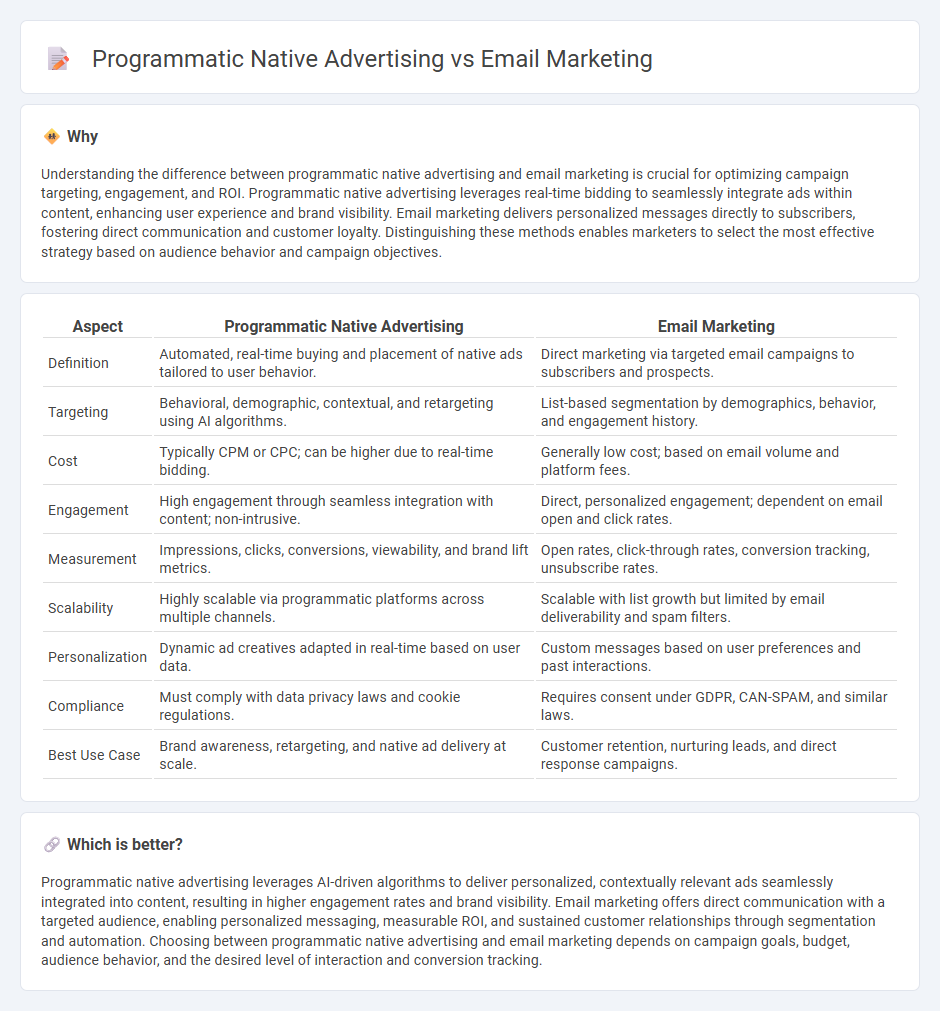
Programmatic native advertising leverages real-time bidding to deliver personalized, contextually relevant ads seamlessly integrated within digital content, enhancing user engagement and brand visibility. Email marketing focuses on direct communication, allowing businesses to nurture relationships through targeted messages, promotions, and personalized offers that drive conversions and customer loyalty. Explore in-depth comparisons and strategies to optimize your marketing mix effectively.
Why it is important
Understanding the difference between programmatic native advertising and email marketing is crucial for optimizing campaign targeting, engagement, and ROI. Programmatic native advertising leverages real-time bidding to seamlessly integrate ads within content, enhancing user experience and brand visibility. Email marketing delivers personalized messages directly to subscribers, fostering direct communication and customer loyalty. Distinguishing these methods enables marketers to select the most effective strategy based on audience behavior and campaign objectives.
Comparison Table
| Aspect | Programmatic Native Advertising | Email Marketing |
|---|---|---|
| Definition | Automated, real-time buying and placement of native ads tailored to user behavior. | Direct marketing via targeted email campaigns to subscribers and prospects. |
| Targeting | Behavioral, demographic, contextual, and retargeting using AI algorithms. | List-based segmentation by demographics, behavior, and engagement history. |
| Cost | Typically CPM or CPC; can be higher due to real-time bidding. | Generally low cost; based on email volume and platform fees. |
| Engagement | High engagement through seamless integration with content; non-intrusive. | Direct, personalized engagement; dependent on email open and click rates. |
| Measurement | Impressions, clicks, conversions, viewability, and brand lift metrics. | Open rates, click-through rates, conversion tracking, unsubscribe rates. |
| Scalability | Highly scalable via programmatic platforms across multiple channels. | Scalable with list growth but limited by email deliverability and spam filters. |
| Personalization | Dynamic ad creatives adapted in real-time based on user data. | Custom messages based on user preferences and past interactions. |
| Compliance | Must comply with data privacy laws and cookie regulations. | Requires consent under GDPR, CAN-SPAM, and similar laws. |
| Best Use Case | Brand awareness, retargeting, and native ad delivery at scale. | Customer retention, nurturing leads, and direct response campaigns. |
Which is better?
Programmatic native advertising leverages AI-driven algorithms to deliver personalized, contextually relevant ads seamlessly integrated into content, resulting in higher engagement rates and brand visibility. Email marketing offers direct communication with a targeted audience, enabling personalized messaging, measurable ROI, and sustained customer relationships through segmentation and automation. Choosing between programmatic native advertising and email marketing depends on campaign goals, budget, audience behavior, and the desired level of interaction and conversion tracking.
Connection
Programmatic native advertising and email marketing share a data-driven approach that enhances audience targeting and personalization. Both strategies utilize user behavior and demographic data to deliver relevant content, increasing engagement and conversion rates. Integrating programmatic native ads into email campaigns leverages automated ad placement, optimizing marketing ROI and user experience.
Key Terms
Segmentation
Email marketing enables precise audience segmentation through demographic data, purchase history, and engagement metrics, ensuring personalized communication that boosts conversion rates. Programmatic native advertising utilizes AI-driven algorithms to segment audiences in real-time based on browsing behavior, context, and interests across multiple platforms for dynamic ad targeting. Explore deeper insights into how effective segmentation strategies can maximize ROI in both channels.
Personalization
Email marketing leverages detailed customer data to create highly personalized messages that target specific segments with tailored content, improving engagement and conversion rates. Programmatic native advertising uses automated technology to deliver contextually relevant ads within the user's browsing experience, adapting dynamically based on real-time behavior and preferences. Discover how combining these strategies can enhance personalization and boost your marketing ROI.
Automation
Email marketing leverages automation tools to personalize and schedule targeted campaigns, increasing engagement through tailored content and timely delivery. Programmatic native advertising uses algorithms and real-time bidding to automatically place ads that blend seamlessly with organic content, optimizing reach and performance across multiple platforms. Discover how integrating automation in these strategies can amplify your marketing effectiveness.
Source and External Links
Email marketing -- a step-by-step guide to getting started - Email marketing involves defining your audience, setting goals, choosing a platform, building and segmenting a list, creating and testing emails, and measuring results to engage customers effectively and affordably.
Email Marketing: Everything you need to know | Mailchimp - Types of email marketing include welcome emails, newsletters, lead nurturing emails, and confirmation emails, each designed to engage customers at different stages of their journey.
What Is Email Marketing? Definition & Tips (2025) | Salesforce US - Successful email marketing focuses on personalization, automation, mobile optimization, clear CTAs, and consistent brand voice to convert leads and build loyalty through direct, targeted messaging.
 dowidth.com
dowidth.com